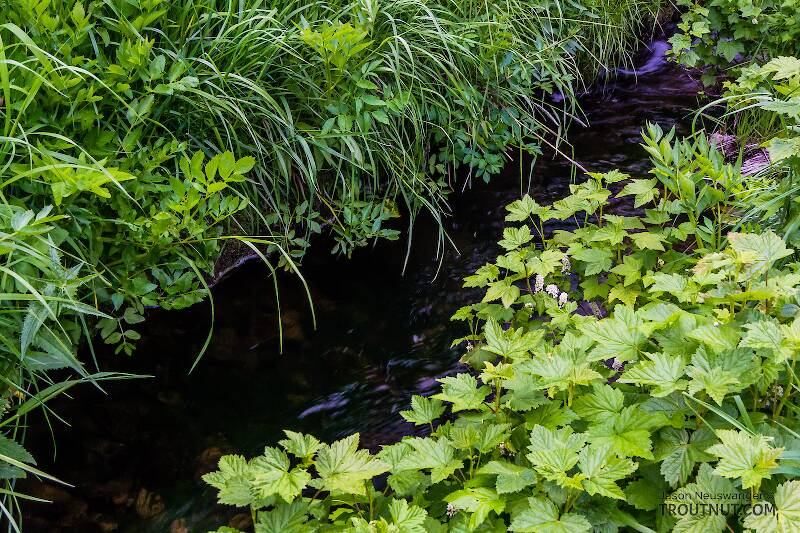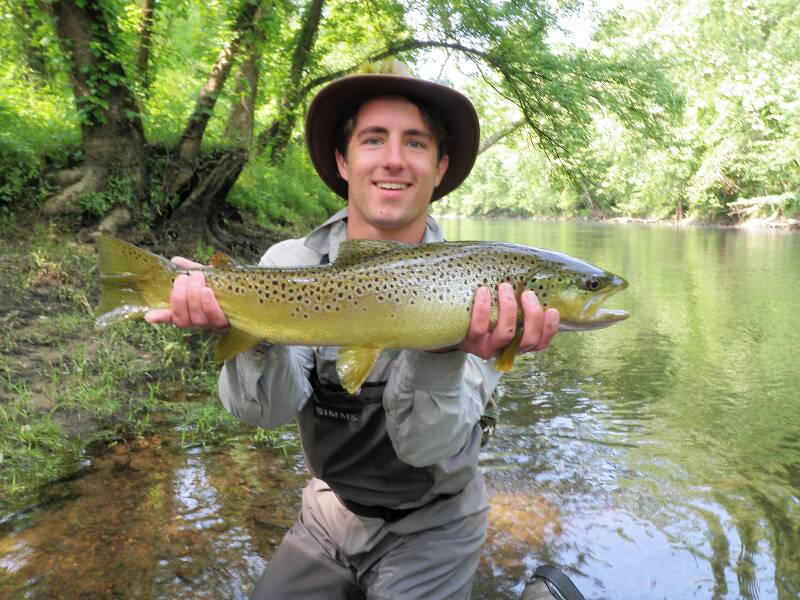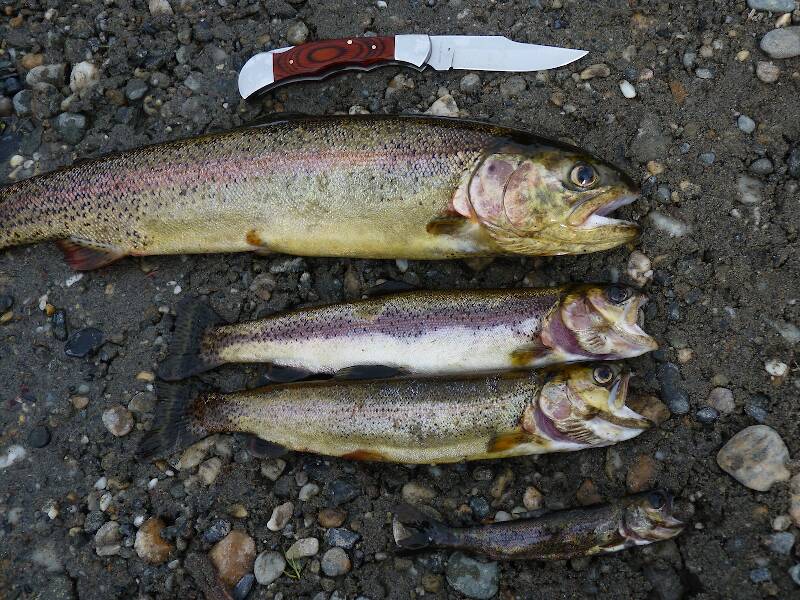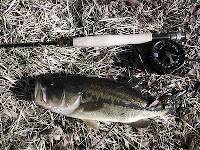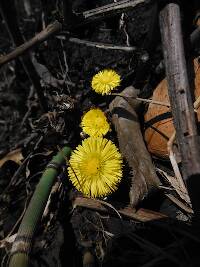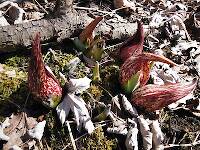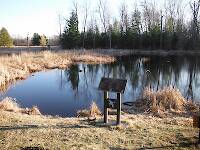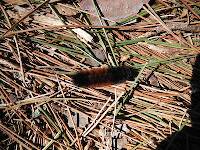
Salmonflies
Pteronarcys californica
The giant Salmonflies of the Western mountains are legendary for their proclivity to elicit consistent dry-fly action and ferocious strikes.
Featured on the forum
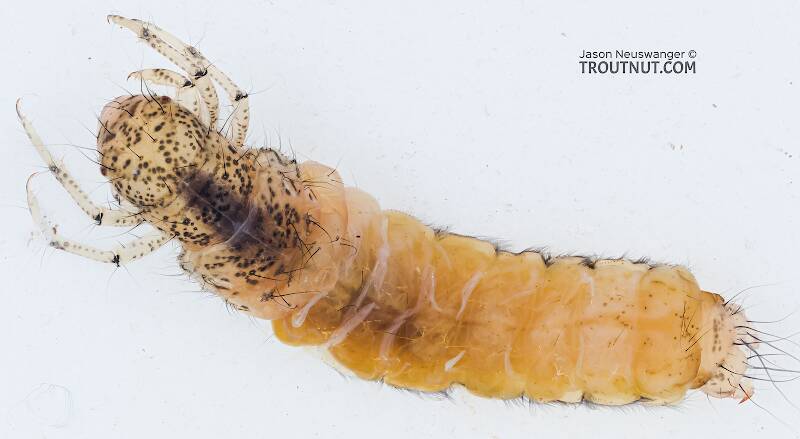
This is a striking caddis larva with an interesting color pattern on the head. Here are some characteristics I was able to see under the microscope, but could not easily expose for a picture:
- The prosternal horn is present.
- The mandible is clearly toothed, not formed into a uniform scraper blade.
- The seems to be only 2 major setae on the ventral edge of the hind femur.
- Chloride epithelia seem to be absent from the dorsal side of any abdominal segments.
Based on these characteristics and the ones more easily visible from the pictures, this seems to be Grammotaulius. The key's description of the case is spot-on: "Case cylindrical, made of longitudinally arranged sedge or similar leaves," as is the description of the markings on the head, "Dorsum of head light brownish yellow with numerous discrete, small, dark spots." The spot pattern on the head is a very good match to figure 19.312 of Merritt R.W., Cummins, K.W., and Berg, M.B. (2019). The species ID is based on Grammotaulius betteni being the only species of this genus known in Washington state.
- The prosternal horn is present.
- The mandible is clearly toothed, not formed into a uniform scraper blade.
- The seems to be only 2 major setae on the ventral edge of the hind femur.
- Chloride epithelia seem to be absent from the dorsal side of any abdominal segments.
Based on these characteristics and the ones more easily visible from the pictures, this seems to be Grammotaulius. The key's description of the case is spot-on: "Case cylindrical, made of longitudinally arranged sedge or similar leaves," as is the description of the markings on the head, "Dorsum of head light brownish yellow with numerous discrete, small, dark spots." The spot pattern on the head is a very good match to figure 19.312 of Merritt R.W., Cummins, K.W., and Berg, M.B. (2019). The species ID is based on Grammotaulius betteni being the only species of this genus known in Washington state.

Troutnut is a project started in 2003 by salmonid ecologist Jason "Troutnut" Neuswanger to help anglers and
fly tyers unabashedly embrace the entomological side of the sport. Learn more about Troutnut or
support the project for an enhanced experience here.
Jesse on Dec 29, 2011December 29th, 2011, 1:26 pm EST
I spent my previous summer exploring some of the east coast's best 'off the map' trout fisheries, or trying to find them anyway. Within the ones that i did come across, i managed to find some great wild trout territory. However, in some of this great territory i would find the occasional small mouth bass or sun fish. Immediately i would focus on ridding the stream of that species. Most of the fish (non-trout) i would take and eat, but some i would simply bank and use as a means of fertilization. It's like an animal would take control of me and i would focus on catching the other predatory fish that were swimming around in these pools. I would catch them until i didn't see anymore signs of them, and wade to the next pool worth inspection. I can't tell you how many non trout species that i killed this summer. A lot of them on streams and tribs that i have fished before and never seen as significant of a sign as invasive species on before. I will continue to kill these fish, whether my actions are minuet or not. To me im helping, even if it is on an extremely small scale. Is this right or wrong?
Most of us fish our whole lives..not knowing its not the fish that we are after.
http://www.filingoflyfishing.com
http://www.filingoflyfishing.com
Wbranch on Dec 29, 2011December 29th, 2011, 1:43 pm EST
Jesse wrote;
"but some i would simply bank and use as a means of fertilization."
and
"Is this right or wrong?"
I for one think it is wrong, mean, maybe illegal, and kind of shitty. If you must resort to this because you have decided to remove "invasive species" (BTW how do you know they are invasive? haven't you ever seen a fishery where wild trout and smallmouth bass co-exist quite well?) do you at least humanely dispatch them before "banking" them. I'd bet if a PA CO saw you banking a smallmouth, which is considered a game fish in PA, he would write you up with a nice citation.
Are you also banking the rainbows and browns you are catching because they surely are not native to any water system east of the Mississippi? For that matter browns were never found in a native environment anywhere in the USA before sometime late in the 19th century when eggs started comng over from Germany and I'm guessing Ireland or Scotland.
"but some i would simply bank and use as a means of fertilization."
and
"Is this right or wrong?"
I for one think it is wrong, mean, maybe illegal, and kind of shitty. If you must resort to this because you have decided to remove "invasive species" (BTW how do you know they are invasive? haven't you ever seen a fishery where wild trout and smallmouth bass co-exist quite well?) do you at least humanely dispatch them before "banking" them. I'd bet if a PA CO saw you banking a smallmouth, which is considered a game fish in PA, he would write you up with a nice citation.
Are you also banking the rainbows and browns you are catching because they surely are not native to any water system east of the Mississippi? For that matter browns were never found in a native environment anywhere in the USA before sometime late in the 19th century when eggs started comng over from Germany and I'm guessing Ireland or Scotland.
Catskill fly fisher for fifty-five years.
JOHNW on Dec 29, 2011December 29th, 2011, 2:02 pm EST
Jesse,
I would have to come down on the wrong side as well. Small mouth are a truly wonderful gamefish and worthy of their place in any wild stream (not to mention they are more native than any trout found in those streams saving brookies which are actually a char). My feeling is we humans do more than our fair share to destroy viable waterways that we should either work to change the root problems i.e. changes in water temp leading to the presence of "warmwater species" instead of killing those fish that are taking advantage of the "newly" available habitat.
While I disagree with your stated actions I am appreciative of your contemplation and even honesty about them.
JW
I would have to come down on the wrong side as well. Small mouth are a truly wonderful gamefish and worthy of their place in any wild stream (not to mention they are more native than any trout found in those streams saving brookies which are actually a char). My feeling is we humans do more than our fair share to destroy viable waterways that we should either work to change the root problems i.e. changes in water temp leading to the presence of "warmwater species" instead of killing those fish that are taking advantage of the "newly" available habitat.
While I disagree with your stated actions I am appreciative of your contemplation and even honesty about them.
JW
"old habits are hard to kill once you have gray in your beard" -Old Red Barn
GldstrmSam on Dec 29, 2011December 29th, 2011, 2:09 pm EST
It seems fine to me if you are ABSOLUTELY sure that the fish you are killing are ONLY invasive fish ( which it sound like they are not). I don't necessarily like killing fish and throwing them away even if it is fertilizing the stream bank. I was always taught, "you kill it you eat it, and if you have no intention of eating it don't kill it".
Just MAKE SURE YOU ARE DOING EVERYTHING LEGALLY, because the bad actions of one fisherman reflect badly on all fishermen to the non-fishing group, and recently there have been people(PETA) trying to stop activities such as fishing, hunting, trapping. DON'T give them any them ground to think that we are a "kill for fun" law breaking group.
If you want to help you could probably go to your DFG( Department of Fish and Game) and ask if there is a way to help with invasive species. Then you could know for sure that you are doing everything legally.
That is my two cents,
Sam
Just MAKE SURE YOU ARE DOING EVERYTHING LEGALLY, because the bad actions of one fisherman reflect badly on all fishermen to the non-fishing group, and recently there have been people(PETA) trying to stop activities such as fishing, hunting, trapping. DON'T give them any them ground to think that we are a "kill for fun" law breaking group.
If you want to help you could probably go to your DFG( Department of Fish and Game) and ask if there is a way to help with invasive species. Then you could know for sure that you are doing everything legally.
That is my two cents,
Sam
There is no greater fan of fly fishing than the worm. ~Patrick F. McManus
Oldredbarn on Dec 29, 2011December 29th, 2011, 5:02 pm EST
Jess,
In my opinion the boys are correct. You need to rethink this practice...Are we going to eliminate Osprey? Merganzers? Mink? Pike? Or Great Blue Heron? Don't know where this ends...
If the warm water species exist in such great numbers, maybe the stream is iffy trout habitat.
So called "garbage fish" or "rough species" are a good food source for the preds of the stream.
Let the stream find its own balance.
Spence
In my opinion the boys are correct. You need to rethink this practice...Are we going to eliminate Osprey? Merganzers? Mink? Pike? Or Great Blue Heron? Don't know where this ends...
If the warm water species exist in such great numbers, maybe the stream is iffy trout habitat.
So called "garbage fish" or "rough species" are a good food source for the preds of the stream.
Let the stream find its own balance.
Spence
"Even when my best efforts fail it's a satisfying challenge, and that, after all, is the essence of fly fishing." -Chauncy Lively
"Envy not the man who lives beside the river, but the man the river flows through." Joseph T Heywood
"Envy not the man who lives beside the river, but the man the river flows through." Joseph T Heywood
Martinlf on Dec 29, 2011December 29th, 2011, 5:07 pm EST
As others have said, I appreciate your honesty, Jesse. And, agreeing with most, uf not all else they have said, I'm especially in agreement with JohnW's comments about smallmouth, which are one of the great native gamefish of the eastern US. In most cases, it seems to me wiser to let Mother Nature sort out which fish are best adapted to thrive in a stream. If a real need to purify a stream exists (and I do understand, and sympathize with your impulse to some degree) that seems a job for trained fisheries biologists who more fully understand the history and dynamics of the stream. It does please me, though, that some people keep trout that are stocked in wild trout streams and release the wild ones.
"He spread them a yard and a half. 'And every one that got away is this big.'"
--Fred Chappell
--Fred Chappell
Jesse on Dec 30, 2011December 30th, 2011, 12:29 am EST
Interesting all around guys, and much appreciated for the honesty. Some further thoughts to think upon also. In Montana and even some other western states theres a fine for catching and releasing northern pike in streams that have solid wild trout populations (such as the Bitterroot outside of Missoula). Also, in areas out west it's frowned upon to release northern pike minnow, and i think its Idaho that you are allowed to bank 6 or 7 of them in a days fishing. What are your thoughts on actions such as this. When i fish in the west i see fisheries that have excellent, reoccurring numbers of wild trout. The east, although it has my heart for trout fishing, struggles a lot more due to stocked trout where they are not needed (in streams that have wild trout populations) and species such as the small mouth. Now i get that small mouth are more native than the brown trout, because all the browns and rainbows east of the Mississippi are wild, not native. And i get that they are a fun game fish and quite a beautiful fish as well. And you must know that the majority of these fish i do eat, and the ones i don't my family and friends enjoy. But when i catch red breasted sun fish in a high mountain stream's deep slow pool, one that i have never seen a fish other than a trout in before, it's a little odd. A lot of it might have to do with all of last years high water and warming temperatures, but it's scary. And most of these streams are ones that have never had these fish in them before (i know this because of old friends passing on their secrets to me). Like i said, i honestly appreciate all the input, and id like to hear more opinions on my further questioning?
Most of us fish our whole lives..not knowing its not the fish that we are after.
http://www.filingoflyfishing.com
http://www.filingoflyfishing.com
Jesse on Dec 30, 2011December 30th, 2011, 12:44 am EST
Another thought i have on this subject is this: Soon, if weather conditions keep allowing it, a lot of our cold water fisheries will warm tremendously and make for better small mouth habitat. Once this happens to certain streams trout might or might not be able to adapt to their new, warmer watershed. Trout will be the first fish to go if water temps stay rising, and bass (of all types) will slowly take over. Now i know it won't happen everywhere, but it is indeed happening now and has great potential to quickly spread across the United States. With this being said, are we going to be satisfied and role with the punches or what? I'm just curious for thoughts because it's this kind of stuff i find myself thinking about sometimes.
Most of us fish our whole lives..not knowing its not the fish that we are after.
http://www.filingoflyfishing.com
http://www.filingoflyfishing.com
PaulRoberts on Dec 30, 2011December 30th, 2011, 5:15 am EST
... in areas out west it's frowned upon to release northern pike minnow ...
These fish are a warmwater species native in the CO River, endangered, and federally protected. Can't imagine where regs would require their removal, or where they threaten trout. Now...the CO River was a "world class" smallmouth fishery until "the Feds" started removing them to protect the endangered native "minnows" -a number of species actually. Talk to the locals and they are PO'd at trading 4lb smallies for "trash fish" -although most of these endangered minnows are fairly large. Interesting conundrum in an area where the fishery means tourist dollars.
But, it depends on your values I guess. The Feds are mandated to protect endangered species; It's part of that "natural biodiversity" idea still kicking around. It's a no-brainer for me. In my mind, trout and bass are ubiquitous, native assemblages are not, are disappearing, and have far fewer friends than the "noble" gamefish.
As to killing everything that invades the romantic domain, I would suggest finding out about each water body -contact the fisheries people in those areas, rather than make guesses.
I once electro-fished a small trout stream in upstate NY that was found to contain blue-spotted sunfish, a tiny and beautiful native species that is rare throughout NY. We were pleased to find them.
GldstrmSam on Dec 30, 2011December 30th, 2011, 1:07 pm EST
Jesse,
If you want to help with invasive species come on up to Alaska.
Northern Pike are over running southern Alaska. They are threatening the wild salmon populations. There are some lakes that are bare of any fish other than Pike.
If you want to help with invasive species come on up to Alaska.
Northern Pike are over running southern Alaska. They are threatening the wild salmon populations. There are some lakes that are bare of any fish other than Pike.
There is no greater fan of fly fishing than the worm. ~Patrick F. McManus
Troutnut on Dec 30, 2011December 30th, 2011, 6:00 pm EST
Jesse, I would definitely urge you to stop killing every non-trout fish you come across in a trout stream, unless you're going to legally keep and eat it. Killing them all is only a good idea in some very specific cases, and you'll know those when a local biologist tells the public about them.
All the specific cases I've heard about concern northern pike, which don't just compete with trout but may eat them as a primary food source. The local TU chapter in northern Wisconsin even has an annual "whack-a-northern" day on one pike-infested trout stream. The fish are kept and fried. If you find occasional fish that might be eating trout (like a pond-escaped largemouth bass, or a pike) then don't feel bad about keeping them for dinner... but don't kill them just for the sake of the trout. It's also important to know that not every trout stream with northern pike is in danger because of them -- many strong trout populations have coexisted with pike for decades. The potential for pike to decimate trout is specific to certain streams, and it depends on temperature, cover, depth, gradient, and a whole bunch of other factors.
Other than northern pike, it's rare for any warm or cool-water species like sunfish and smallmouth bass to substantively damage a trout population in a stream. I've never even heard of a documented case of it, although I haven't searched thoroughly. Trout and those other fish have very different ideal water temperatures. They're naturally going to overlap at downstream boundaries where the water warms up, and those species ranges and compositions are based on temperature. You could kill all the bass and sunfish in a river downstream of where you find trout, and the trout aren't going to magically take over that part of the river. You could also kill all the trout, and the bass and sunfish would not colonize the trout water. Killing a few of one type of fish around their boundary isn't going to help the other type.
All the specific cases I've heard about concern northern pike, which don't just compete with trout but may eat them as a primary food source. The local TU chapter in northern Wisconsin even has an annual "whack-a-northern" day on one pike-infested trout stream. The fish are kept and fried. If you find occasional fish that might be eating trout (like a pond-escaped largemouth bass, or a pike) then don't feel bad about keeping them for dinner... but don't kill them just for the sake of the trout. It's also important to know that not every trout stream with northern pike is in danger because of them -- many strong trout populations have coexisted with pike for decades. The potential for pike to decimate trout is specific to certain streams, and it depends on temperature, cover, depth, gradient, and a whole bunch of other factors.
Other than northern pike, it's rare for any warm or cool-water species like sunfish and smallmouth bass to substantively damage a trout population in a stream. I've never even heard of a documented case of it, although I haven't searched thoroughly. Trout and those other fish have very different ideal water temperatures. They're naturally going to overlap at downstream boundaries where the water warms up, and those species ranges and compositions are based on temperature. You could kill all the bass and sunfish in a river downstream of where you find trout, and the trout aren't going to magically take over that part of the river. You could also kill all the trout, and the bass and sunfish would not colonize the trout water. Killing a few of one type of fish around their boundary isn't going to help the other type.
Jason Neuswanger, Ph.D.
Troutnut and salmonid ecologist
Troutnut and salmonid ecologist
PaulRoberts on Dec 31, 2011December 31st, 2011, 7:31 am EST
Jason is very right that the species you mention do not really compete. A sunfish, or LMbass, in a stream is a transient situation. Sure, keep the oddball red-breast. But I wouldn't worry about sunfish taking over a trout stream, habitat requirements are mutually exclusive. If the sunnies can survive and reproduce, the trout probably can't.
Jason mentions marginal downstream habitats that flux year to year as to the border between trout habitat and warmer water species. That said, and as a fellow stream explorer you probably already have found similar stuff, there are places where trout co-exist with warmer water species. But, even if temperatures support both to some degree, they tend to use different current speeds as well.
I've surveyed "marginal" trout waters via shocking gear and it is fascinating to watch the different species roll up around the "wand" as you move through the micro-habitats that exist within and between those "riffles and pools". A healthy diverse stream is wonderful. There's one in central NY that just happens to be, (or was), relatively undeveloped in which we shocked 41 fish species over it's length. Brookies dominated headwaters, smallies below. Such a stream is a treasure.
Some small streams had a "chub problem" (from the trout fishers perspective and... well..trout fishers pay the bills) -which competed with young trout. But as these waters cool in the long term (associated with forest regeneration) trout will begin to outcompete the chubs. Killing chubs though isn't likely to solve the problem -they are a "symptom" of something larger.
Fallfish are a common CNY "chub" (large minnow) that could compete with trout somewhat, but they too do best in water warmer than most trout can handle well. Areas where both occur the two species are separated by current speed requirements -at those warmer temps. If 'bows could handle things a little warmer and fallfish a little cooler, the two would be direct competitors.
Good topic. Thanks for bringing it up.
Jason mentions marginal downstream habitats that flux year to year as to the border between trout habitat and warmer water species. That said, and as a fellow stream explorer you probably already have found similar stuff, there are places where trout co-exist with warmer water species. But, even if temperatures support both to some degree, they tend to use different current speeds as well.
I've surveyed "marginal" trout waters via shocking gear and it is fascinating to watch the different species roll up around the "wand" as you move through the micro-habitats that exist within and between those "riffles and pools". A healthy diverse stream is wonderful. There's one in central NY that just happens to be, (or was), relatively undeveloped in which we shocked 41 fish species over it's length. Brookies dominated headwaters, smallies below. Such a stream is a treasure.
Some small streams had a "chub problem" (from the trout fishers perspective and... well..trout fishers pay the bills) -which competed with young trout. But as these waters cool in the long term (associated with forest regeneration) trout will begin to outcompete the chubs. Killing chubs though isn't likely to solve the problem -they are a "symptom" of something larger.
Fallfish are a common CNY "chub" (large minnow) that could compete with trout somewhat, but they too do best in water warmer than most trout can handle well. Areas where both occur the two species are separated by current speed requirements -at those warmer temps. If 'bows could handle things a little warmer and fallfish a little cooler, the two would be direct competitors.
Good topic. Thanks for bringing it up.
Troutnut on Dec 31, 2011December 31st, 2011, 7:59 am EST
Killing chubs though isn't likely to solve the problem -they are a "symptom" of something larger.
That's a very good point. Except sometimes for northern pike, an unwanted fish in a trout stream is usually not a problem itself, but a symptom of some other problem, and killing the fish will make no difference.
And, of course, sometimes it's not even a problem -- it's just the natural state of some of the thermally marginal areas on the boundary between coldwater and warmwater areas. When you find areas like that in an extremely productive stream, you may find some extremely large trout, because they grow fastest in warmer water (up to a point) if they have lots of food. The biggest stream trout I know if in Wisconsin come from thermally marginal reaches where trout coexist with smallmouth bass and muskies year-round and there are awesome populations of bugs and minnows to eat.
Jason Neuswanger, Ph.D.
Troutnut and salmonid ecologist
Troutnut and salmonid ecologist
Entoman on Dec 31, 2011December 31st, 2011, 10:21 am EST
...it's rare for any warm or cool-water species like sunfish and smallmouth bass to substantively damage a trout population...
This assertion may be true for moving water, but many fine stillwater fisheries in the West famous for their healthy populations of free rising trout and hatches have been decimated by the introduction of sunfish. Callibaetis and sunfish don't mix well - the former are soon wiped out by the latter's highly efficient method of predation. It's a beautiful mayfly capable of wonderful symbiosis with trout if we could have just left well enough alone... One of the saddest changes I've witnessed in the last 20 years or so.
"It's not that I find fishing so important, it's just that I find all other endeavors of Man equally unimportant... And not nearly as much fun!" Robert Traver, Anatomy of a Fisherman
Troutnut on Dec 31, 2011December 31st, 2011, 12:00 pm EST
This assertion may be true for moving water, but many fine stillwater fisheries in the West
True, I was only talking about rivers. Lakes are a whole other complicated ballgame.
Jason Neuswanger, Ph.D.
Troutnut and salmonid ecologist
Troutnut and salmonid ecologist
Entoman on Dec 31, 2011December 31st, 2011, 12:49 pm EST
True, I was only talking about rivers
I knew you were. I used your statement as a way to bridge the segue, not to imply disagreement or error.;)
Lakes are a whole other complicated ballgame
Yes they are. I think it is in stillwaters where the use of the terms "warmwater" and "coldwater" are especially capable of causing a lot of misconceptions, as there is an implied dichotomy that doesn't exist. I need your help to explain the science behind it, but I have observed flourishing populations of sunfish above 6,000 ft., and even survive in ponds where the trout suffered "winter-kill" (higher tolerance for low oxygen levels?). It seems to me the limiting factor for sunfish is too much current and/or a lack of weedy littoral zones, rather than temperature.
"It's not that I find fishing so important, it's just that I find all other endeavors of Man equally unimportant... And not nearly as much fun!" Robert Traver, Anatomy of a Fisherman
PaulRoberts on Dec 31, 2011December 31st, 2011, 1:07 pm EST
Fish "metabolic engines" run best (growth, health/stress) within an "optimum" temperature window. They can acclimate to temps outside of this window of course, otherwise they'd not last the year. Then there are lethal temperatures that also differ for different species.
If a species is forced to eek out a living outside its thermal window for long periods, competition from better suited species can become a stressor.
If a species is forced to eek out a living outside its thermal window for long periods, competition from better suited species can become a stressor.
Entoman on Dec 31, 2011December 31st, 2011, 1:27 pm EST
While higher temeratures are a very obvious limiting factor for "coldwater" species like trout, I have not found the opposite to be true for "warmwater" species like some sunfish. If you give a blue-ear a weed bed full of callibaetis, scuds, and damsel nymphs to munch, it becomes the stressor to the trout rather than the other way around - even in "cold water."
"It's not that I find fishing so important, it's just that I find all other endeavors of Man equally unimportant... And not nearly as much fun!" Robert Traver, Anatomy of a Fisherman
Entoman on Dec 31, 2011December 31st, 2011, 3:39 pm EST
The colder water seems to affect their (sunfish) size potential, but not their fecundity.
"It's not that I find fishing so important, it's just that I find all other endeavors of Man equally unimportant... And not nearly as much fun!" Robert Traver, Anatomy of a Fisherman
Jesse on Jan 1, 2012January 1st, 2012, 1:02 pm EST
Interesting stuff guys, it's nice to get different opinions on a topic such as this one.
Most of us fish our whole lives..not knowing its not the fish that we are after.
http://www.filingoflyfishing.com
http://www.filingoflyfishing.com
Quick Reply
Related Discussions
Topic
Replies
Last Reply
37
Dec 15, 2012
by GldstrmSam
by GldstrmSam
Five days of warmwater flyfishing in southeastern Michigan - from Jonathon
In Fishing Reports by Jmd123
In Fishing Reports by Jmd123
0
Jul 22, 2009
by Jmd123
by Jmd123

